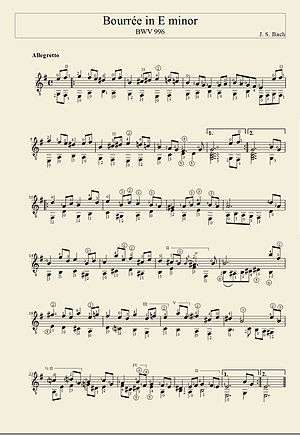Bourrée in E minor

Bourrée in E minor is a popular lute piece, the fifth movement from Suite in E minor for Lute, BWV 996 (BC L166) written by Johann Sebastian Bach. This piece is arguably one of the most famous pieces among guitarists.[1]
A bourrée was a type of dance that originated in France with quick duple meter and an upbeat.[2] Though the bourrée was popular as a social dance and shown in theatrical ballets during the reign of Louis XIV of France, the Bourrée in E minor was not intended for dancing.[2] Nonetheless, some of the elements of the dance are incorporated in the piece.[2]
Bach wrote his lute pieces in a traditional score rather than in lute tablature, and some believe that Bach played his lute pieces on the keyboard.[2] No original script of the Suite in E minor for Lute by Bach is known to exist.[3] However, in the collection of one of Bach's pupils, Johann Ludwig Krebs, there is one piece ("Praeludio – con la Suite da Gio: Bast. Bach") that has written "aufs Lauten Werck" ("for the lute-harpsichord") in unidentified handwriting.[3] Some argue that despite this reference, the piece was meant to be played on the lute as demonstrated by the texture.[3] Others argue that since the piece was written in E minor, it would be incompatible with the baroque lute which was tuned to D minor.[4] Nevertheless, it may be played with other string instruments, such as the guitar, mandola or mandocello, and keyboard instruments, and it is especially well-known among guitarists.[5] The tempo of the piece should be fairly quick and smooth, since it was written to be a dance. It also demonstrates counterpoint, as the two voices move independently of one another.[1] Furthermore, the Bourrée in E minor demonstrates binary form.[6]
 |
J.S. Bach "Bourrée in E minor" (BWV 996)
Performed on an organ |
| Problems playing these files? See media help. | |
In classical music
Robert Schumann quotes the first 14 notes of this memorable theme (transposed to G minor) in #3 of the Op. 60, 6 Fugues on B–A–C–H, where he neatly combines it with the B♭ A C B motif. There also appears to be an echo of this reference in the next fugue, #4.
In popular culture
| "Bourée" | ||||
|---|---|---|---|---|
| Song by Jethro Tull from the album Stand Up | ||||
| Released | 1 August 1969 | |||
| Recorded | April 1969 at Morgan Studios, London | |||
| Genre | Jazz, Jazz Fusion, Progressive rock | |||
| Length | 3:46 | |||
| Label | Island, Reprise | |||
| Writer(s) | J.S. Bach, arr. Ian Anderson | |||
| Producer(s) | Ian Anderson, Terry Ellis | |||
| Stand Up track listing | ||||
| ||||
The piece has been used by a number of musicians:
- Paul McCartney has said in interviews and on tours that the songs "Blackbird" and "Jenny Wren" were both inspired by variations and alterations to the bourrée.[7]
- The London Blues-rock group Bakerloo released their arrangement of the tune, titled "Drivin' Bachwards", as a single on Harvest Records (HAR 5004) in July 1969. The same recording appeared on their self-titled debut album (Harvest SHVL 762) the following December.
- Jethro Tull used the piece in the third track in their August 1969 album Stand Up, "Bourée".[8] Alternative versions of the same track appear on The Jethro Tull Christmas Album and A Little Light Music and is a band favorite for live concerts.
- Led Zeppelin has used this piece in live performances while playing "Heartbreaker".[9]
- Tenacious D used it for their songs, "Rock Your Socks" and "Classico", which was played in Tenacious D in The Pick of Destiny.[10]
- Yngwie Malmsteen has also been known to integrate this, among other works by Bach, into his live sets.[11][1]
- Leo Kottke performs "Bouree" on the album Mudlark.[1]
- Lenny Breau re-harmonized this piece and recorded it on the album Minors Aloud under the title "On a Bach Bouree".
- Alter Bridge used this riff as the chorus to "Wayward One", the closing track of their 2007 album Blackbird.
- Jam-80 a short-lived Icelandic band featuring Björk recorded it on a demo cassette.
- It has been adapted for the Commodore 64 version of Black Lamp.
- Blizzard composer Glenn Stafford used it in the soundtrack for Warcraft II: Tides of Darkness in the second half of the song titled "Human 2".
See also
References
- 1 2 3 4 Mark Phillips; Jon Chappell (2008). Guitar Exercises for Dummies. For Dummies. p. 87. ISBN 978-0-470-38766-5.
- 1 2 3 4 Nancy Bachus; Daniel Glover (2000). The Baroque Spirit, Bk 2: Book & CD. Alfred Music Publishing. p. 28. ISBN 978-0-7390-0502-6.
- 1 2 3 Hannu Annala; Heiki Mätlik (2008). Handbook of Guitar and Lute Composers. Mel Bay Publications. p. 32. ISBN 978-0-7866-5844-2.
- ↑ Johann Sebastian Bach; Jozsef Eotvos (2002). J. S. Bach: The Complete Lute Works. Mel Bay Publications. p. vi. ISBN 978-0-7866-6819-9.
- ↑ Elizabeth T. Knuth. "Bourrée". Retrieved 2007-12-18.
- ↑ Bill Purse (2003). The PrintMusic! primer: mastering the art of music notation with Finale PrintMusic!. Hal Leonard Corporation. p. 164. ISBN 978-0-87930-754-7.
- ↑ Bass Player. "He Can Work It Out". Retrieved 2007-12-18.
- ↑ Jethro Tull, Scott Allen Nollen, Ian Anderson (McFarland, 2001) Page 47
- ↑ Songfacts. "Heartbreaker by Led Zeppelin". Retrieved 2007-12-18.
- ↑ Kickass Classical. "The Most Popular Classical Music". Retrieved 2007-12-18.
- ↑ Chordie. "Bachs Bouree by Yngwie Malmsteen". Retrieved 2007-12-18.
External links
- Lute Pieces, BWV 995-1000: Scores at the International Music Score Library Project
- Sheet Music
- Sheet Music from Mutopia
- Guitar Information
- The Origin of Jethro Tull's Bourrée